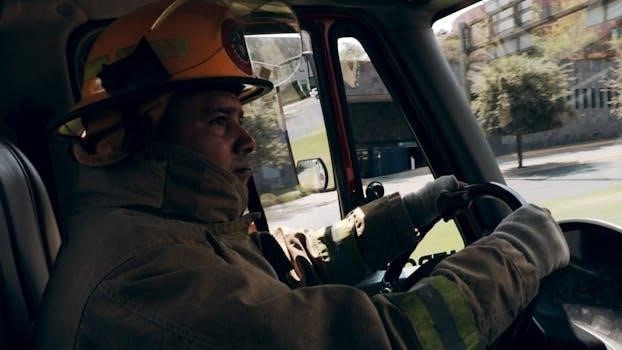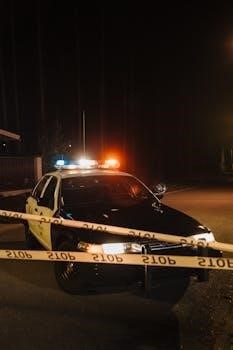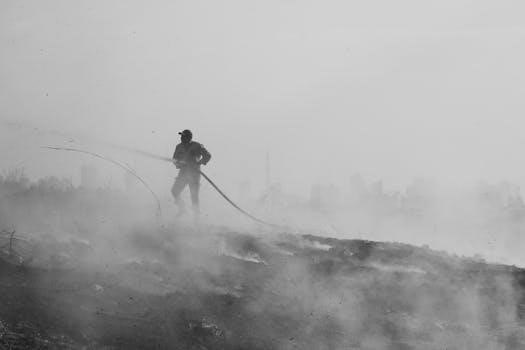
First Alert 9120B Manual⁚ A Comprehensive Guide
This comprehensive guide provides detailed information regarding the First Alert 9120B smoke and carbon monoxide alarm․ It includes essential details like installation‚ maintenance‚ troubleshooting‚ and safety precautions․ Refer to this manual for optimal protection and functionality of your First Alert 9120B․
The First Alert 9120B is a hardwired combination smoke and carbon monoxide alarm designed to provide comprehensive protection for your home and family․ This device integrates both smoke and carbon monoxide detection into a single unit‚ offering a convenient and reliable safety solution․
As a hardwired alarm‚ the 9120B is connected directly to your home’s electrical system‚ ensuring continuous operation․ It also includes a 9-volt battery backup‚ providing uninterrupted protection even during power outages․ This feature is crucial for maintaining safety when you need it most․
The First Alert 9120B utilizes ionization sensing technology for smoke detection‚ which is particularly effective at detecting fast-flaming fires․ Additionally‚ it incorporates advanced carbon monoxide sensing technology to detect dangerous CO levels‚ alerting you to this silent and deadly threat․

This manual provides a detailed guide to the First Alert 9120B‚ covering everything from installation and testing to maintenance and troubleshooting․ By following the instructions in this manual‚ you can ensure that your 9120B alarm is functioning correctly and providing the protection you expect․ Understanding the features and operation of your First Alert 9120B is key to maintaining a safe home environment․

Key Features of the 9120B Alarm
The First Alert 9120B alarm boasts several key features designed to enhance home safety and provide reliable protection against fire and carbon monoxide hazards․ One of its primary features is its combination detection capability‚ integrating both smoke and CO detection into a single‚ convenient unit․ This eliminates the need for separate alarms‚ simplifying installation and maintenance․
Being a hardwired alarm‚ the 9120B connects directly to your home’s electrical system‚ ensuring a constant power supply․ In the event of a power outage‚ the alarm seamlessly switches to its 9-volt battery backup‚ guaranteeing continuous protection․ This dual power source provides peace of mind‚ knowing that your home is protected even during emergencies․
The 9120B employs ionization smoke sensing technology‚ which is highly effective at detecting fast-flaming fires․ It also features an advanced electrochemical CO sensor‚ capable of accurately detecting carbon monoxide levels in your home․ These sensors work together to provide comprehensive protection against both fire and CO poisoning․
Furthermore‚ the alarm includes a test/silence button‚ allowing you to easily test the alarm’s functionality and silence nuisance alarms․ The end-of-life timer provides an audible alert when the alarm needs to be replaced‚ typically after ten years․ These features contribute to the alarm’s user-friendly design and ensure long-lasting reliability․
Installation Instructions for the 9120B
Before commencing the installation of your First Alert 9120B alarm‚ prioritize safety․ ELECTRICAL SHOCK HAZARD⁚ Turn off the power at the circuit breaker to the area where you plan to install the alarm․ Failure to do so may result in serious injury or death․ Ensure the mounting location is suitable – ideally on a ceiling or high on a wall‚ at least 4 inches from where the wall and ceiling meet․ Avoid areas near kitchens or bathrooms where steam or cooking fumes could trigger false alarms․
Remove the mounting bracket from the back of the alarm by twisting it counterclockwise․ Position the bracket on the chosen surface and mark the screw locations․ Drill pilot holes if necessary‚ then secure the bracket using the provided screws․ Connect the alarm wires to your home’s wiring‚ matching the colors carefully (black to black‚ white to white‚ and red to the red wire from the alarm)․ Secure the wire connections with wire connectors․
Attach the alarm to the mounting bracket by aligning it and twisting clockwise until it locks into place․ Install a new 9-volt battery into the battery compartment․ Restore power at the circuit breaker and test the alarm by pressing the test button․ The alarm should sound a loud‚ consistent beep․ If it does not‚ double-check the wiring and battery connections․ Repeat the testing procedure monthly to ensure proper functionality․
Understanding the Alarm Signals
The First Alert 9120B utilizes distinct alarm signals to communicate different types of emergencies‚ enabling you to respond appropriately and promptly․ A crucial aspect of owning this device is understanding these signals to ensure your family’s safety․ A continuous‚ loud‚ repeating pattern of three beeps indicates the presence of smoke or fire․ This requires immediate action‚ such as evacuating the premises and contacting emergency services․
In contrast‚ a pattern of four beeps signals the detection of carbon monoxide (CO)․ CO is an odorless‚ colorless gas‚ making it particularly dangerous․ Upon hearing this signal‚ immediately move to fresh air‚ and then call emergency services or a qualified professional to investigate the source of the CO․ A single chirp sound‚ usually occurring every minute‚ typically signifies a low battery․ Replace the battery immediately when you hear this chirp to ensure the alarm’s continued functionality during an actual emergency․
The test button‚ when pressed‚ should trigger a loud‚ consistent alarm sound‚ confirming that the alarm’s circuitry and siren are working correctly․ Regularly test your alarm to ensure it’s functioning correctly․ Familiarize yourself with these distinct signals to react swiftly and effectively during an emergency․
Testing and Maintenance Procedures
Regular testing and maintenance are vital for ensuring the First Alert 9120B functions correctly and provides reliable protection․ Testing the alarm weekly is highly recommended․ To test‚ simply press and hold the test button on the alarm’s cover until the alarm sounds․ The alarm should emit a loud‚ consistent beep‚ indicating that the sensor‚ electronics‚ and horn are functioning properly․ If the alarm fails to sound‚ check the battery and ensure it is correctly installed․ If the alarm still doesn’t sound after replacing the battery‚ replace the entire unit․
Dust and debris can accumulate on the alarm sensor‚ affecting its sensitivity․ Clean the alarm at least once every six months․ Use a vacuum cleaner with a soft brush attachment to gently remove dust from the exterior of the alarm․ Avoid using water‚ detergents‚ or solvents to clean the alarm‚ as these can damage the sensor and electronics․ Never paint the alarm‚ as paint can block the sensor openings and prevent it from detecting smoke or carbon monoxide․
Keep the alarm free from obstructions․ Do not place anything near the alarm that could block airflow to the sensor․ Replace the battery at least once a year‚ or immediately when the low battery warning sounds․ Following these simple testing and maintenance procedures will help ensure the First Alert 9120B provides continuous and reliable protection for your home and family․
Battery Replacement Guide
The First Alert 9120B utilizes a 9-volt battery as a backup power source‚ ensuring continuous operation during power outages․ Regular battery replacement is crucial for maintaining the alarm’s reliability․ When the alarm begins to chirp intermittently‚ it indicates a low battery and requires immediate replacement․ It’s recommended to replace the battery at least once a year‚ even if the low battery warning hasn’t sounded․ A good practice is to replace the battery when you change your clocks for daylight saving time․
To replace the battery‚ first‚ gently twist the alarm counterclockwise to detach it from the mounting bracket․ Locate the battery compartment on the back of the alarm; Open the battery compartment and remove the old battery․ Properly dispose of the old battery according to local regulations․ Insert a new 9-volt battery into the battery compartment‚ ensuring correct polarity (+ and -)․ Close the battery compartment securely․
Reattach the alarm to the mounting bracket by twisting it clockwise until it locks into place․ Test the alarm by pressing and holding the test button until the alarm sounds․ A loud‚ consistent beep indicates that the new battery is functioning correctly․ If the alarm doesn’t sound‚ double-check the battery installation and ensure that the battery is fresh․ If the alarm still fails to sound after replacing the battery‚ the unit may need to be replaced․

Troubleshooting Common Issues
The First Alert 9120B is generally reliable‚ but occasional issues may arise․ One common problem is nuisance alarms‚ which can be triggered by steam from showers‚ cooking fumes‚ or excessive dust; Ensure proper ventilation in these areas․ Try relocating the alarm if nuisance alarms persist․ A persistent chirping sound usually indicates a low battery․ Replace the battery immediately as described in the battery replacement guide․ If chirping continues after battery replacement‚ the alarm may be malfunctioning and require replacement․
If the alarm fails to sound during a test‚ check the battery’s expiration date and ensure it’s correctly installed․ If the battery is new and properly installed‚ the unit may be defective and should be replaced․ If the alarm sounds intermittently without any apparent cause‚ it could be due to electrical interference or a faulty sensor․ Try resetting the alarm by disconnecting it from the power source (if hardwired) and removing the battery for a few minutes before reconnecting․ If problems continue‚ consult a qualified electrician or contact First Alert support;
Never attempt to repair the alarm yourself‚ as this could damage the unit and void the warranty․ Always follow the manufacturer’s instructions for troubleshooting and maintenance․ Regular testing and proper maintenance are essential for ensuring the alarm’s effectiveness in detecting smoke and carbon monoxide․
Safety Precautions and Warnings
Prioritize safety when installing and maintaining your First Alert 9120B smoke and carbon monoxide alarm․ Always disconnect power at the breaker before handling hardwired alarms to prevent electrical shock․ Never ignore an alarm; investigate the cause immediately․ Understand the difference between smoke and carbon monoxide alarms and their respective sounds․ Develop and practice a fire escape plan with your family‚ designating a meeting point outside the home․
Test the alarm regularly‚ following the instructions in the testing and maintenance section․ Replace the battery promptly when the low battery signal sounds․ Do not paint over or cover the alarm‚ as this can impair its functionality․ Keep the alarm free from dust and debris by vacuuming or wiping it down regularly․ If you are unsure about any aspect of installation or maintenance‚ consult a qualified professional․
Be aware that this alarm is not intended for use by hearing-impaired individuals․ Consider installing specialized alarms with visual or tactile alerts for those with hearing impairments․ This device is designed to provide early warning of fire and carbon monoxide hazards․ However‚ it is not a substitute for careful fire prevention practices and responsible behavior․
Where to Purchase First Alert Products
First Alert products‚ including the 9120B smoke and carbon monoxide alarm‚ are widely available through various retailers․ You can find them at most major home improvement stores like Home Depot and Lowe’s‚ both in-store and online․ These stores often offer competitive pricing and a wide selection of First Alert safety products․ Additionally‚ large retailers like Walmart and Target also carry First Alert alarms‚ providing convenient options for purchasing during your regular shopping trips․
Online marketplaces such as Amazon․com offer a vast selection of First Alert products‚ often with customer reviews and detailed product descriptions to help you make an informed decision․ Be sure to check for authorized sellers to ensure you are purchasing a genuine First Alert product․ Furthermore‚ smaller hardware stores and local retailers may also stock First Alert alarms‚ providing a more personalized shopping experience and the opportunity to support local businesses․

Finally‚ you can check the First Alert website for a list of authorized dealers in your area․ This can be a helpful way to find retailers that specialize in safety products and can offer expert advice․ Remember to compare prices and consider shipping costs when purchasing online to ensure you get the best deal․
Contacting First Alert Support
If you encounter any issues with your First Alert 9120B smoke and carbon monoxide alarm or have questions regarding its operation‚ First Alert provides several avenues for support․ The most direct method is to visit the official First Alert website‚ where you can find a comprehensive FAQ section addressing common concerns․ You can also access a library of user manuals and troubleshooting guides specific to your model‚ which may provide immediate solutions to your problems․
For more personalized assistance‚ First Alert offers customer support via telephone․ The phone number is typically listed on the product packaging‚ the First Alert website‚ and within the user manual․ When calling‚ be prepared to provide your model number (9120B) and a detailed description of the issue you are experiencing․ First Alert also offers support through email‚ allowing you to submit your questions in writing and receive a response from a support representative․
Before contacting support‚ gather all relevant information‚ such as the date of purchase and any error messages displayed by the alarm․ This will help the support team diagnose the problem more efficiently․ Finally‚ keep in mind that First Alert may also offer online chat support‚ providing real-time assistance for quick inquiries․ Check their website for availability and hours of operation․